Experimental Investigation of Column Separation Using Rapid Closure of an Upstream Valve
Abstract
:1. Introduction
2. Experimental Apparatus
3. Observations and Results
3.1. Column Separation Behaviors and Synchronous Pressure Surges
- (a)
- Closing the valve (t = 0.0–0.05 s): When the static pressure head in each tank reached the target values (here, HT1 = 4.22 m and HT2 = 3.53 m, then V0 = 1.027 m/s), the ball valve began to close (t = 0.0 s). The operation time of the ball valve was 0.05 s. Once the valve action stopped, obvious vibration and movement were observed.
- (b)
- Phase-1 (t = 0.048–0.157 s): The duration of visible cavitation was 0.09 s. Before the valve stopped action, the pressure at PT6# dropped to the vapor pressure level (at t = 0.048 s). Meanwhile, a cavity resembling “white clouds” had already appeared in the position of the pipeline flange, as shown in Frame 1. There was no clear gas–liquid interface for this cavitation structure. Then, the cavity dilated rapidly, and the gas–liquid interface close to PT6# became clear, eventually occupying the entire pipe cross-section, as shown in Frames 2 and 3. At 0.064 s (Frame 3), tiny bubbles appeared at the top of the pipe wall and expanded towards Tank 2#, indicating that a region of vaporous cavitation had formed. After this, the “white clouds” slowed their expansion rate and eventually reached their maximum size at 0.088 s (Frame 4). During this period, the mist cavity structure developed gradually into several little bubbles with clear gas–liquid interfaces. Then, the bubble number density increased quickly and eventually stopped at 0.108 s (Frame 5). Coinciding with the maximum bubble number density, the tiny bubbles in the cavity structure were eliminated gradually, showing a screw-type evolutional path. Following the complete elimination of the vaporous region at the top of the pipe wall (t = 0.128 s, see Frame 6), the number of tiny bubbles in the cavity structure rapidly diminished, while some bubbles gradually developed into a mist structure. All cavities vanished entirely by 0.139 s, and the pressure at PT6# began to rise, almost instantaneously reaching a maximum value of 281.75 m in 0.004 s, which is nearly three times that of the Joukowsky pressure rise. Subsequently, the damped pressure oscillation at PT6# showed high frequency and high amplitude characteristics. In addition, almost immediately after the cavities collapsed, a resounding noise could be heard following obvious pipeline vibration and movement.
- (c)
- Phase-2 (t = 0.157–0.237 s): The duration of visible cavitation was 0.061 s. When t = 0.157 s (Frame 7), a mist cavitation structure appeared throughout the entire pipe, while the pressure at PT6# was slightly larger than the vaporization pressure (it reached Hv in 0.001 s). The “mist” quickly developed into “bubble clouds” composed of large amounts of tiny bubbles with clear gas–liquid interfaces, expanding downstream with a screw-type evolutional path, as shown in Frames 7–9. The maximum length of the cavitation structure, which was longer than the one in Phase-1, was reached at 0.181 s (Frame 9). Compared with Phase-1, the tiny bubble number density in Phase-2 was lower, and the vaporous region at the top of the pipe wall in the shooting area was more obvious. Then, the front of the “bubble clouds” turned to “mist”, backing up towards BV2#, as shown in Frame 10. Unlike Phase-1, repeated transformations from “mist” to “bubble clouds” could be observed. The transformation process stopped at t = 0.216 s, and the cavitation in the shooting area eventually presented in the form of mist. At 0.0004 s, the pressure at PT6# reached its the maximum, albeit lower than that of Phase-1. Importantly, a small amount of mist structure could be observed even though the pressure at PT6# was larger than that in Hv, as shown in Frame 11 (t = 0.217 s). This structure flickered with the oscillations in pressure. This may have been the result of the release of gases dissolved in water, which would also explain the decrease in wave speed in Phase-2.
- (d)
- Subsequent phases: The durations of visible cavitation for Phase-3, Phase-4, and Phase-5 were 0.036 s, 0.031 s, and 0.012 s, respectively. The dynamic behaviors of column separation in Phase-3, Phase-4, and Phase-5 were similar to those in Phase-2. The cavitation structure shapes adjacent to BV2# and reaching maximum size are displayed in Frames 12, 13, and 14, respectively. The amount of gas released in each phase increased as time went on, which reduced the wave speed further.
- (e)
- After Phase-5′s end (t > 0.369 s): The formation, expansion, and contraction of tiny bubbles could be observed in the pipeline several times, even though the pressure at PT6# was larger than that in Hv, as shown in Frame 15. After the pressure oscillations becoming flat, these bubbles moved towards the top of the pipe wall and were eventually suspended at the top wall.
3.2. Types of Pressure Oscillation Patterns
3.3. Influence of Quantities on Column Separation Events
3.3.1. Effect of Initial Flow Velocity
3.3.2. Effect of Reservoir Static Heads
3.3.3. Effect of Pipe Length
3.3.4. Changing Trends of Maximum Pipeline Pressure
4. Conclusions
- (1)
- The dynamic behaviors and transient regimes of column separation can be summarized as follows: (a) when the pressure drops to vapor pressure level, “mist clouds” initially appear near the valve and rapidly expand downstream until they occupy the entire pipe cross-section; (b) the cavitation structures can manifest as “mist clouds” with distinct gas–liquid interfaces, “bubble clouds” composed of numerous tiny bubbles with clear gas–liquid interfaces, or a combination thereof that can transform into each other; (c) the rate of expansion-condensation and the process of shape changes for bubbles at different positions within a cavitation structure are not the same, with several repeated expansion-condensation processes occurring before the cavitation structure vanishes completely; (d) following the collapse of a cavitation structure, an instantaneous sharp pressure oscillation with high frequency and amplitude propagates along the pipeline; (e) after the cavities collapse, gas release is observed, which increases over time in each phase, leading to reduced wave speeds.
- (2)
- Based on variations in the duration of column separation (sequential decrease or not) and the occurrence position of maximum pressure (following the first cavity collapse in the valve or not), four types of pressure oscillation pattern were identified in these experimental tests.
- (3)
- The influence of piping system quantities on pressure oscillation patterns can be summarized as follows: (a) under the condition of a constant downstream reservoir static head, when the initial velocity increases, the type of pressure oscillation pattern transitions from a nonsequential decrease in the duration of column separation (i.e., Type 3 or 4) to a sequential decrease in duration (i.e., Type 1 or 2); (b) for similar initial flow velocities, the types of pressure oscillation pattern remain consistent, indicating that the reservoir static head has a slight impact on the type of pressure oscillation pattern in the column separation event on the downstream side of the closure valve; (c) a shorter pipeline results in shorter cavitation duration (approximately 40% for Phase-1), but this is not necessarily the same for maximum pipeline pressure.
- (4)
- In all test cases, the maximum pipeline pressure exceeded 150 times the reservoir static pressure. For constant reservoir static pressure, increasing initial flow velocity initially raises and then lowers the maximum pipeline pressure before increasing it again. This trend becomes more pronounced with decreasing reservoir static pressure.
Author Contributions
Funding
Institutional Review Board Statement
Informed Consent Statement
Data Availability Statement
Acknowledgments
Conflicts of Interest
Nomenclature
| a | wave speed (m/s) |
| L | pipeline length (m) |
| T | pipeline period of pressure wave reflection (s) |
| hf | total pressure head loss (m) |
| D | inner pipe diameter (m) |
| V | flow velocity (m/s) |
| g | gravitational acceleration (m/s2) |
| Hmax | maximum pipeline pressure (m) |
| HT1 | static pressure head at Tank 1 (m) |
| HT2 | static pressure head at Tank 2 (m) |
| Hv | vapor vaporization pressure head (m) |
| V0 | initial flow velocity (m/s) |
| t | time (s) |
| tc | valve closure time (s) |
References
- Bergant, A.; Simpson, A.R.; Tijsseling, A.S. Water hammer with column separation: A historical review. J. Fluid Struct. 2006, 22, 135–171. [Google Scholar] [CrossRef]
- Streeter, V.L. Water hammer Analysis. J. Hydraul. Div. 1969, 95, 1959–1972. [Google Scholar] [CrossRef]
- Bergant, A.; Simpson, A.R. Pipeline column separation flow regimes. J. Hydraul Eng. 1999, 125, 835–848. [Google Scholar] [CrossRef]
- Bergant, A.; Simpson, A.R. Estimating unsteady friction in transient cavitating pipe flow. In Proceedings of the Second International Conference on Water Pipeline Systems, Edinburgh, Scotland, UK, 24–26 May 1994. [Google Scholar]
- Zhou, L.; Wang, H.; Bergant, A.; Tijsseling, A.S.; Liu, D.; Guo, S. Godunov-Type Solutions with Discrete Gas Cavity Model for Transient Cavitating Pipe Flow. J. Hydraul. Eng. 2018, 144, 04018017. [Google Scholar] [CrossRef]
- Kranenburg, C. Transient Cavitation in Pipelines. Ph.D. Thesis, Delft University of Technology, Delft, The Netherlands, 1974. [Google Scholar]
- Shu, J.-J. Modelling vaporous cavitation on fluid transients. Int. J. Press. Vessel. Pip. 2003, 80, 187–195. [Google Scholar] [CrossRef]
- Simpson, A.R. Large Water Hammer Pressures Due to Column Separation in Sloping Pipes. Ph.D. Thesis, The University of Michigan, Ann Arbor, MI, USA, 1986. [Google Scholar]
- Sadafi, M.; Riasi, A.; Nourbakhsh, S.A. Cavitating flow during water hammer using a generalized interface vaporous cavitation model. J. Fluids Struct. 2012, 34, 190–201. [Google Scholar] [CrossRef]
- Wang, H.; Zhou, L.; Liu, D.; Karney, B.; Wang, P.; Xia, L.; Ma, J.; Xu, C. CFD Approach for Column Separation in Water Pipelines. J. Hydraul. Eng. 2016, 142, 04016036. [Google Scholar] [CrossRef]
- Warda, H.A.; Wahba, E.M.; Salah El-Din, M. Computational Fluid Dynamics (CFD) simulation of liquid column separation in pipe transients. Alex. Eng. J. 2020, 59, 3451–3462. [Google Scholar] [CrossRef]
- Khani, D.; Lim, Y.H.; Malekpour, A. Calculating Column Separation in Liquid Pipelines Using a 1D-CFD Coupled Model. Mathematics 2022, 10, 1960. [Google Scholar] [CrossRef]
- Martin, C.S. Experimental investigation of column separation with rapid closure of downstream valve. In Proceedings of the 4th International Conference on Pressure Surges, Bath, UK, 21–23 September 1983. [Google Scholar]
- Mitosek, M. Study of transient vapor cavitation in series pipe systems. J. Hydraul. Eng. 2000, 126, 904–911. [Google Scholar] [CrossRef]
- Arfaie, M. Pressure Transient Analysis Including Column Separation and Behaviour of Long Pipelines. Ph.D. Thesis, Newcastle University, Newcastle, UK, 1989. [Google Scholar]
- Adamkowski, A.; Lewandowski, M. Investigation of Hydraulic Transients in a Pipeline with Column Separation. J. Hydraul. Eng. 2012, 138, 935–944. [Google Scholar] [CrossRef]
- Kashada, M.A.M. Modelling of Unsteady Pipe Flow with “Liquid Column Separation” (Water Hammer Induced Transient Cavitation). Ph.D. Thesis, Newcastle University, Newcastle, UK, 2017. [Google Scholar]
- Safwat, H.H.; Van Den Polder, J. Experimental and Analytic Data Correlation Study of Water Column Separation. J. Fluids Eng. 1973, 95, 91–97. [Google Scholar] [CrossRef]
- Zheng, Y.; Suo, L.; Qu, B.; Zhang, J.; Liu, D. Youya shushui guandao xitong hanqi shuichui yanjiu [Study on water hammer with gas in pressurized water delivery pipeline system]. J. Hohai Univ. 2005, 33, 277–281. [Google Scholar] [CrossRef]
- Autrique, R.; Rodal, E.; Sánchez, A.; Carmona, L. Physical model studies of water column separation. IOP Conf. Ser. Earth Environ. Sci. 2012, 15, 022014. [Google Scholar] [CrossRef]
- Soares, A.K.; Covas, D.I.C.; Carrico, N.J.G. Transient vaporous cavitation in viscoelastic pipes. J. Hydraul. Res. 2012, 50, 228–235. [Google Scholar] [CrossRef]
- Soares, A.K.; Covas, D.I.C.; Ramos, H.M.; Reis, L.F.R. Unsteady Flow with Cavitation in Viscoelastic Pipes. Int. J. Fluid Mach. Syst. 2009, 2, 269–277. [Google Scholar] [CrossRef]
- Baltzer, R.A. Column Separation Accompanying Liquid Transients in Pipes. J. Basic. Eng. 1967, 89, 837–846. [Google Scholar] [CrossRef]
- Himr, D. Investigation and Numerical Simulation of a Water Hammer with Column Separation. J. Hydraul. Eng. 2015, 141, 04014080. [Google Scholar] [CrossRef]
- White, F.M. Fluid Mechanics, 7th ed.; Mcgraw-Hill: New York, NY, USA, 2011; p. 356. [Google Scholar]

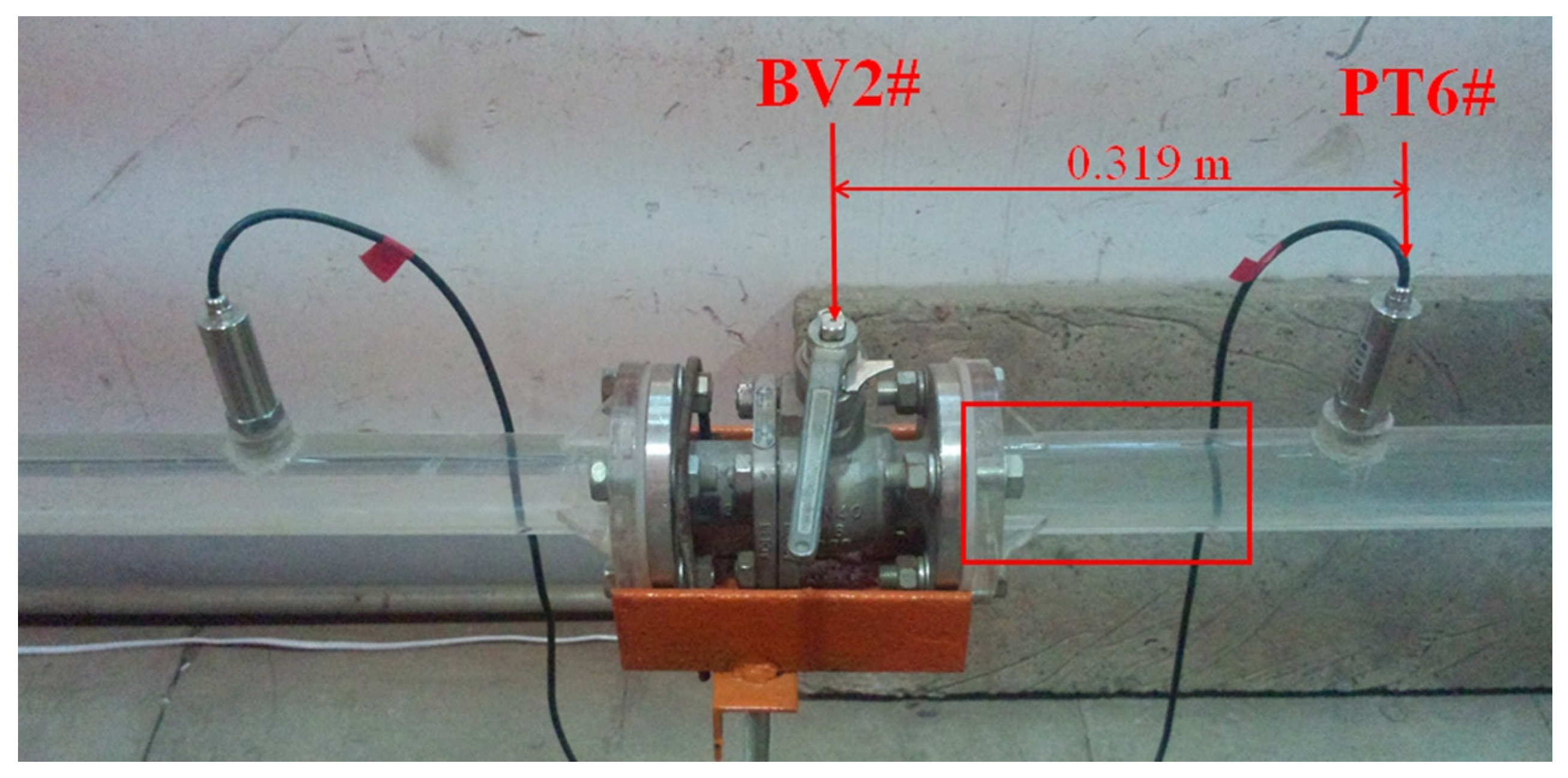


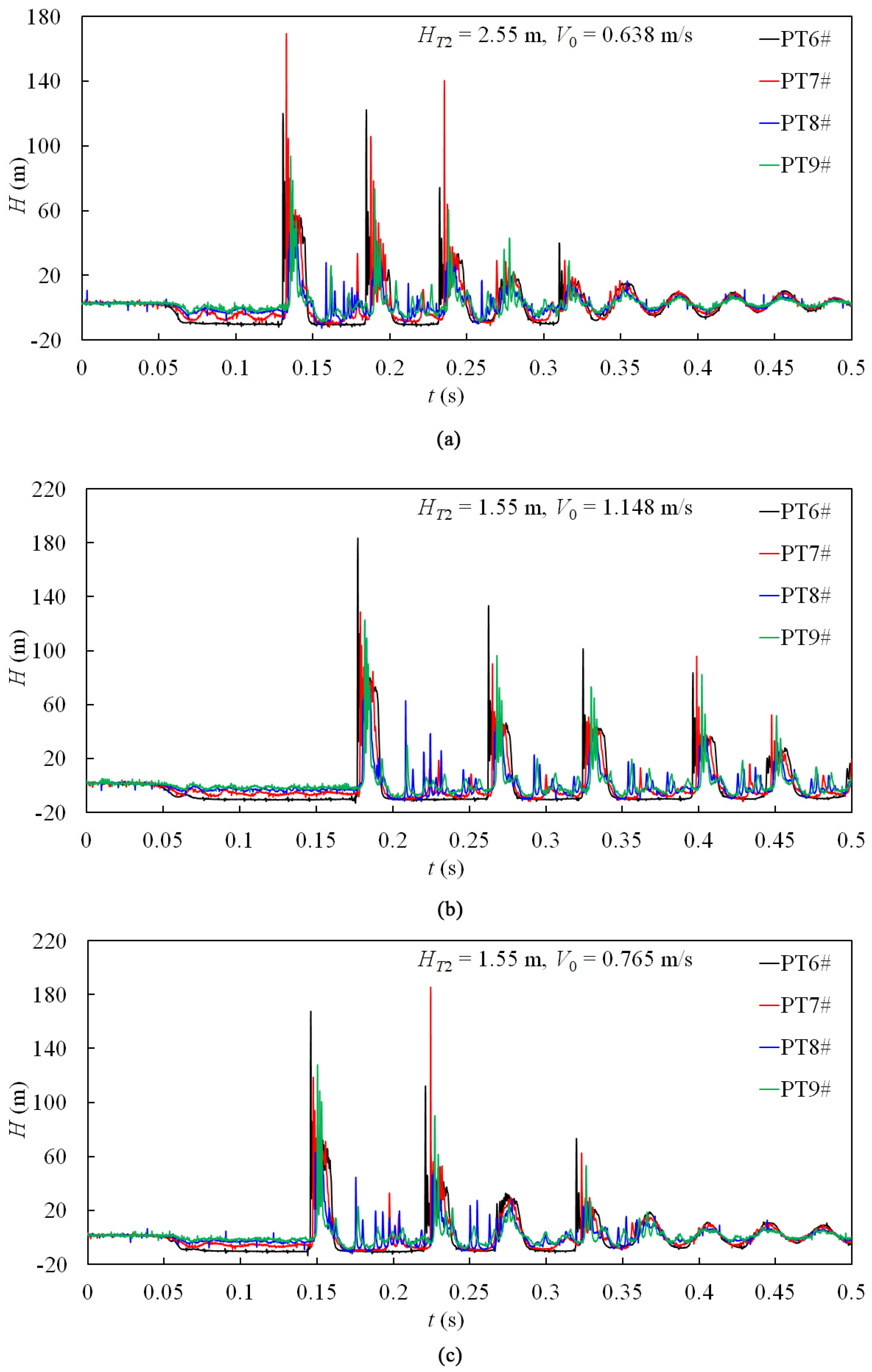
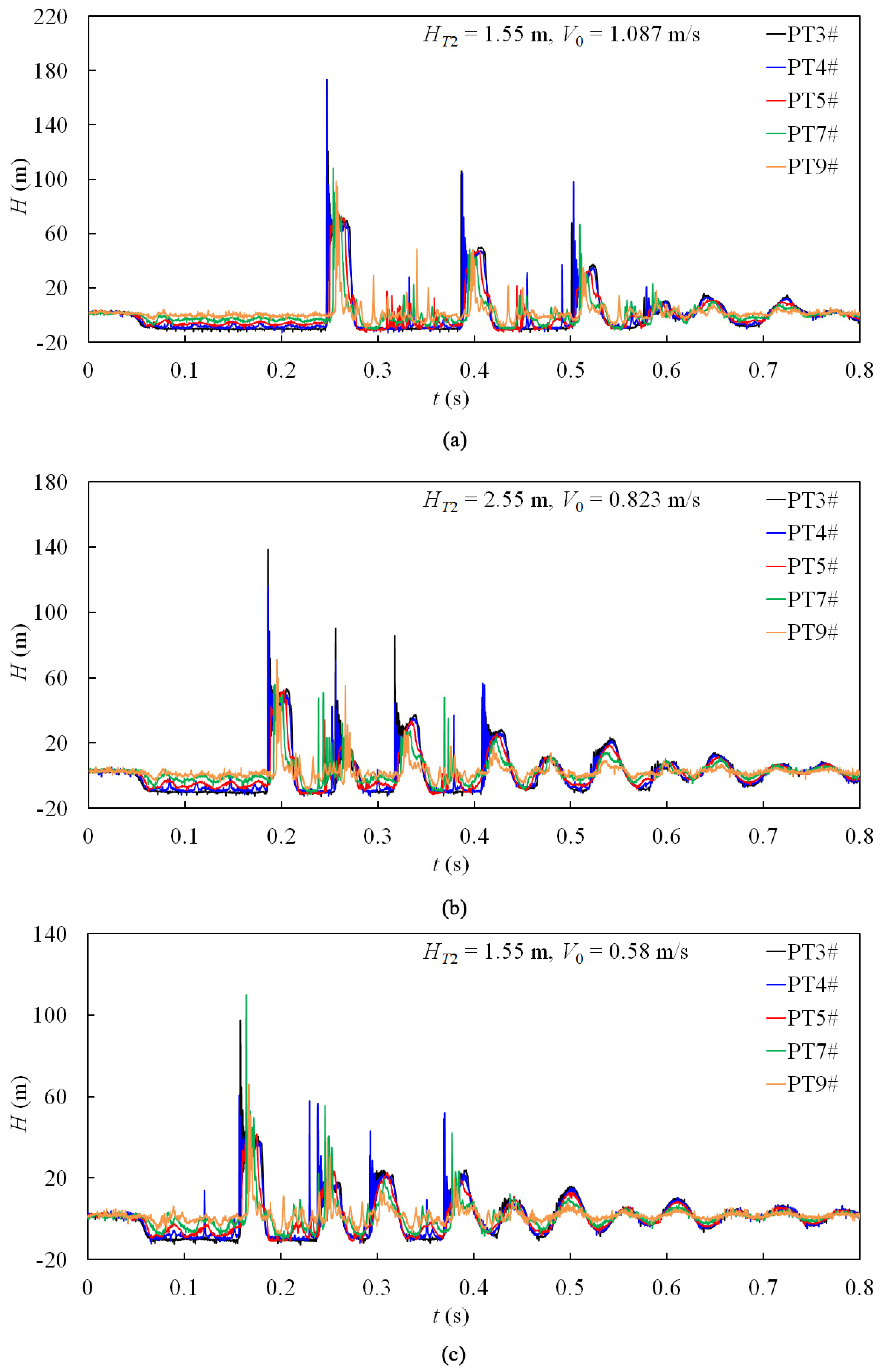

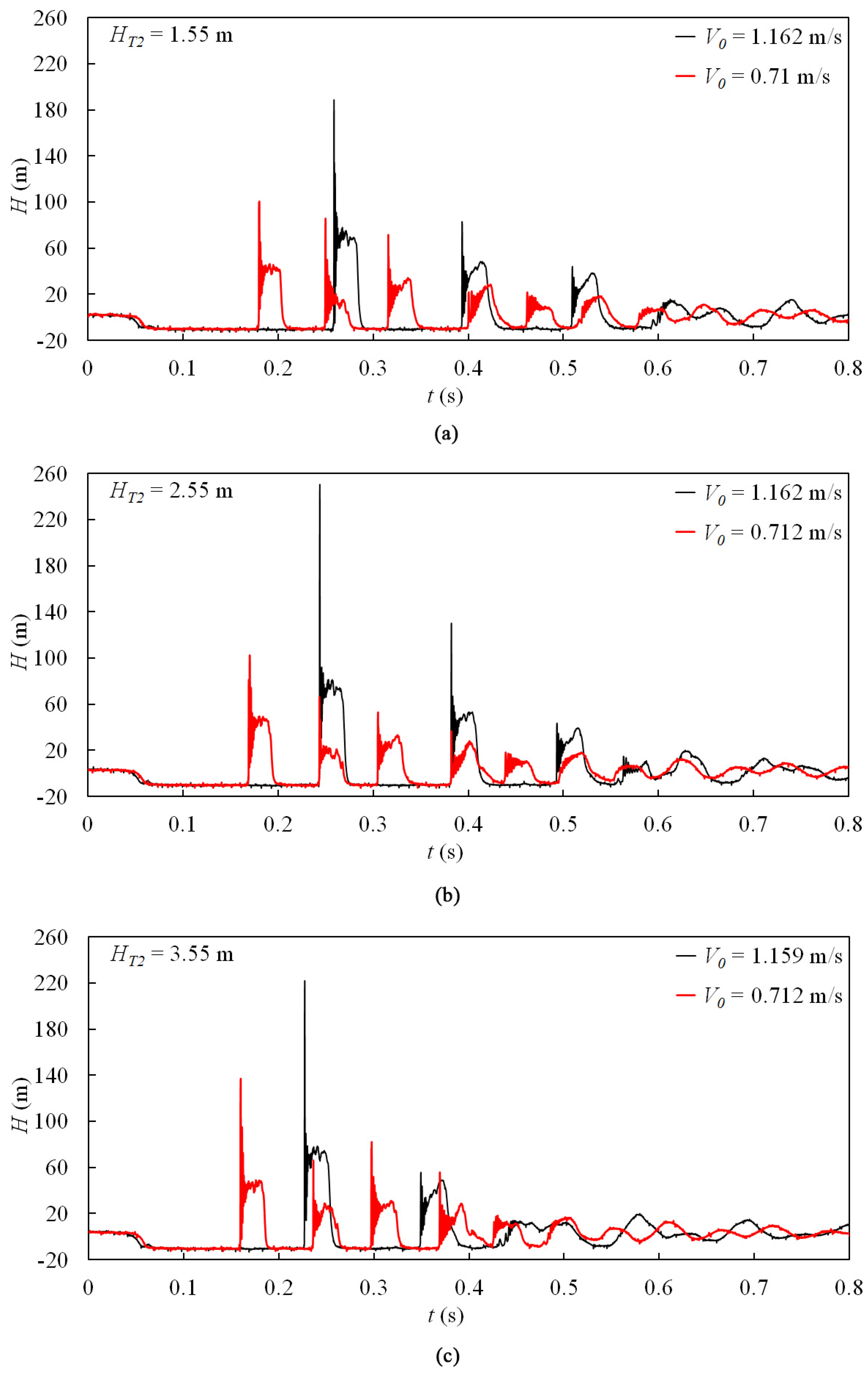


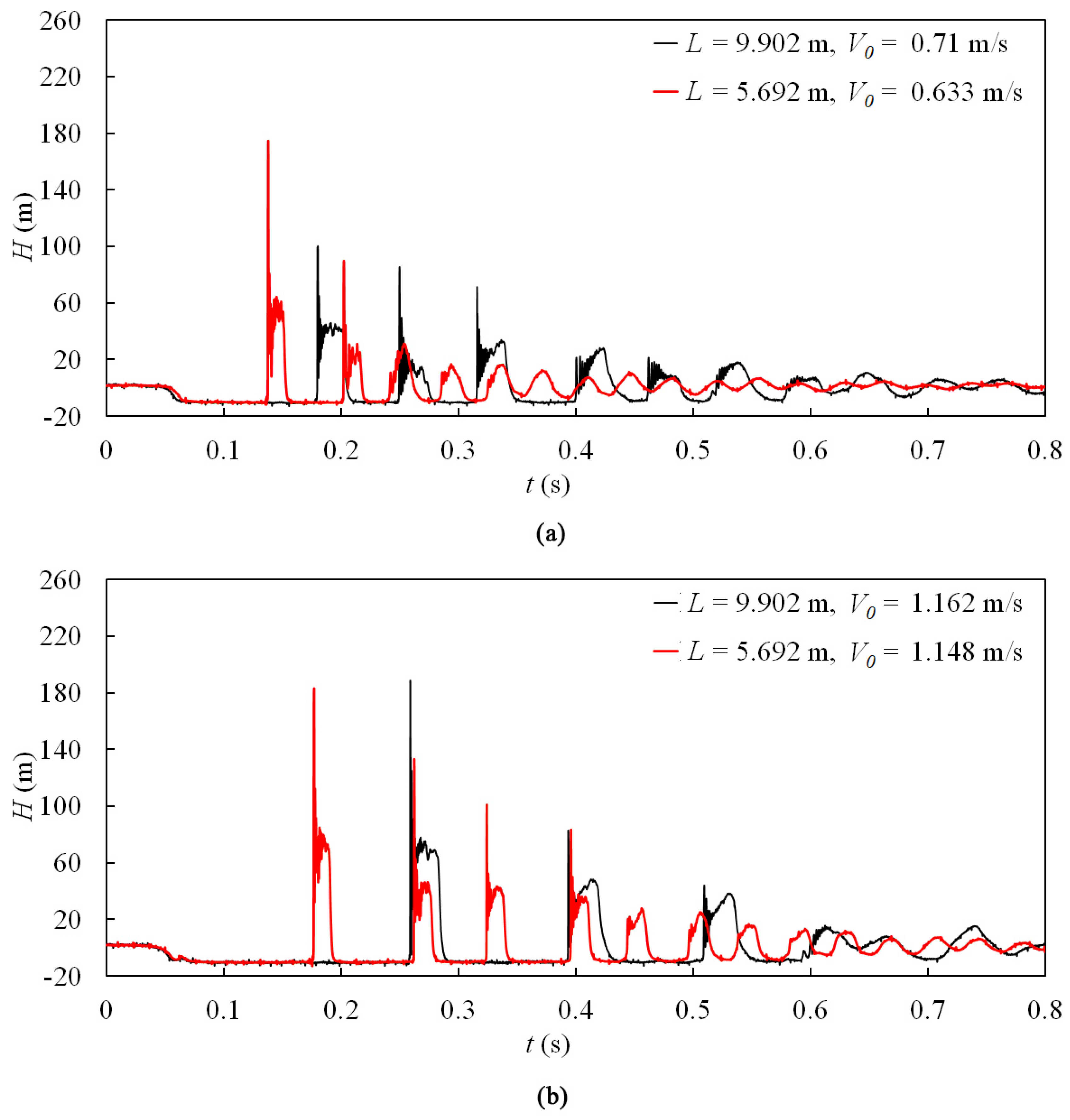
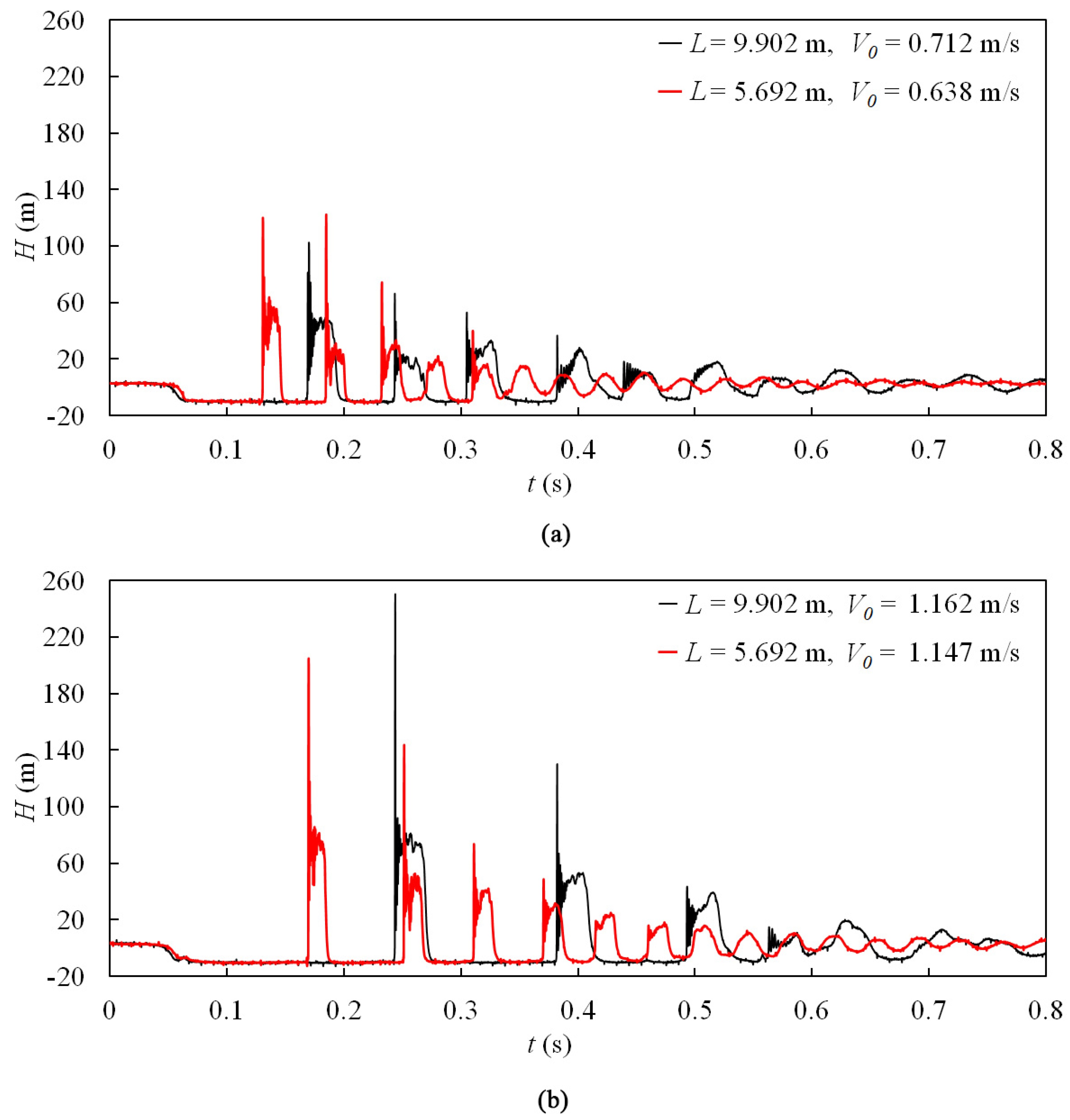
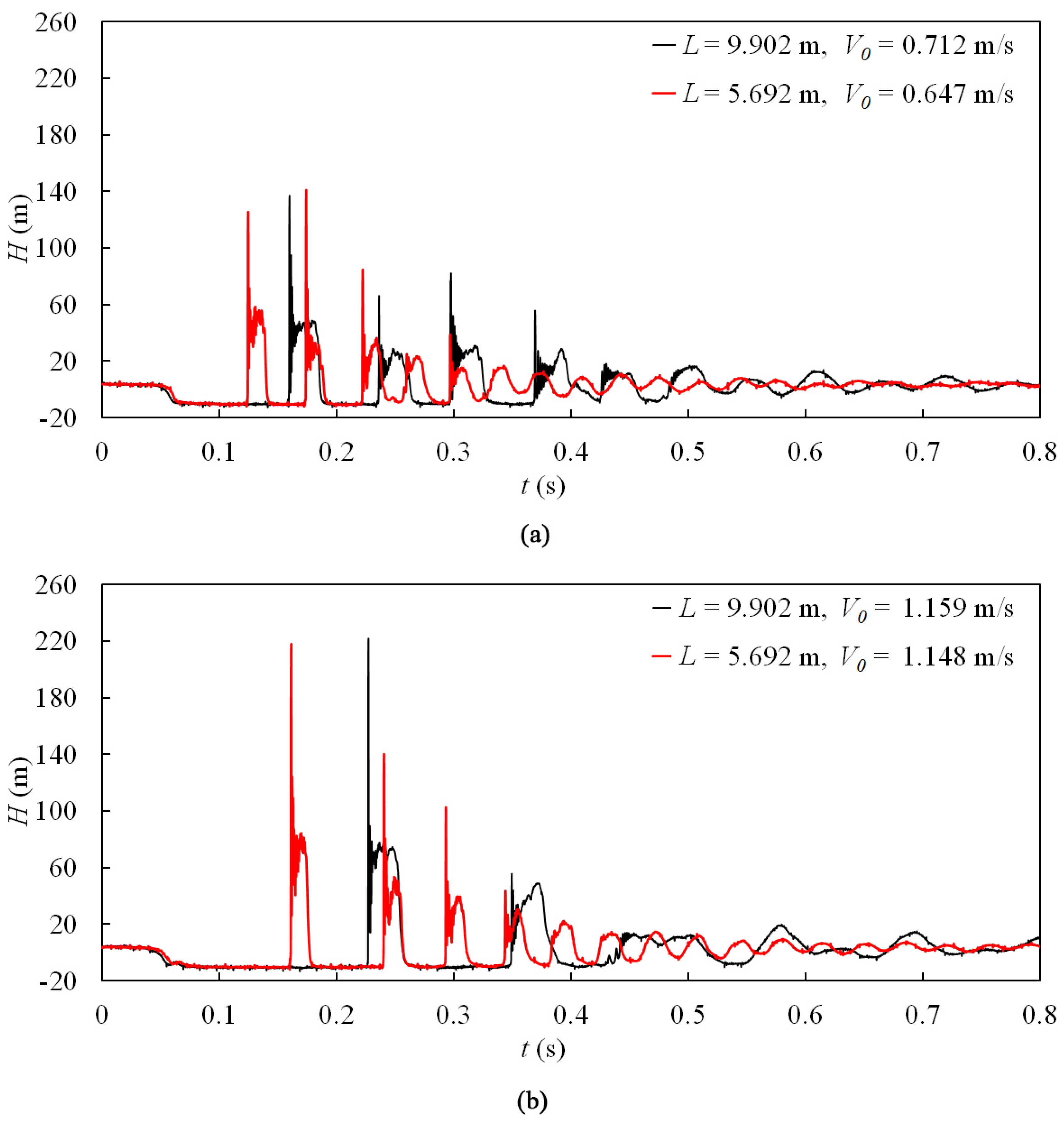
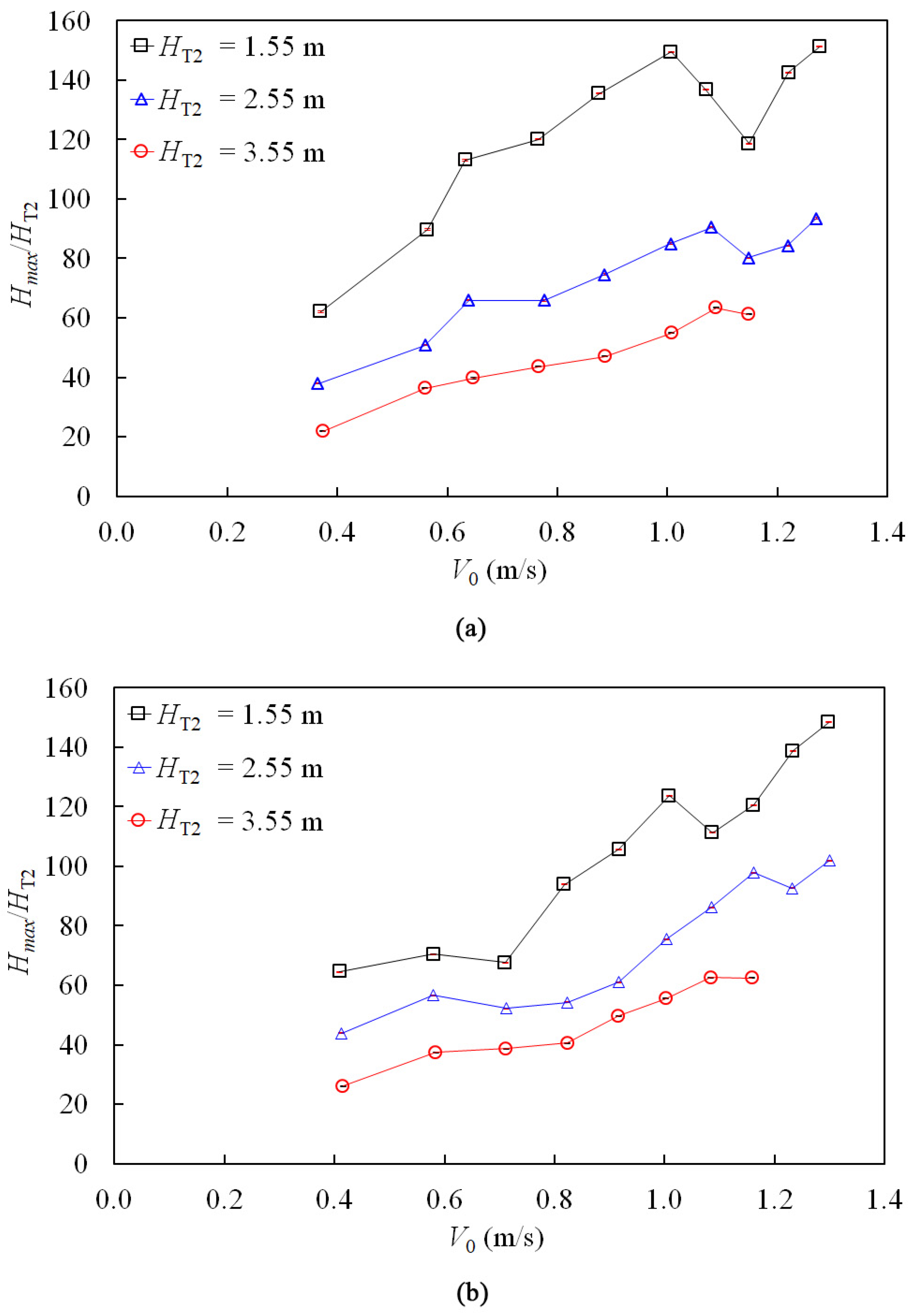
| No. | PT1# | PT2# | PT3# | PT4# | PT5# | PT6# | PT7# | PT8# | PT9# |
|---|---|---|---|---|---|---|---|---|---|
| Horizontal distance from Tank 1 (m) | 0.726 | 1.3 | 2.006 | 3.112 | 5.596 | 6.241 | 8.222 | 9.805 | 10.42 |
| Operation Valve | Flow Direction | Static Pressure Head at the Reservoir | Experiment Numbers | |
|---|---|---|---|---|
| HT1 | HT2 | |||
| BV1# or BV2# | From Tank 1 to Tank 2 | 1.65~2.55 m, with H = 0.01 ± 0.002 m | 1.55 m | 10 |
| 2.65~3.55 m, with H = 0.01 ± 0.002 m | 2.55 m | 10 | ||
| 3.65~4.35 m, with H = 0.01 ± 0.002 m | 3.55 m | 8 | ||
| Type No. | Duration of Column Separation | Maximum Pressure Head | ||
|---|---|---|---|---|
| Sequentially Decreasing | Non-Sequentially Decreasing | First Collapse of Cavities at the Valve | Not at Valve | |
| 1 | √ | √ | ||
| 2 | √ | √ | ||
| 3 | √ | √ | ||
| 4 | √ | √ | ||
Disclaimer/Publisher’s Note: The statements, opinions and data contained in all publications are solely those of the individual author(s) and contributor(s) and not of MDPI and/or the editor(s). MDPI and/or the editor(s) disclaim responsibility for any injury to people or property resulting from any ideas, methods, instructions or products referred to in the content. |
© 2023 by the authors. Licensee MDPI, Basel, Switzerland. This article is an open access article distributed under the terms and conditions of the Creative Commons Attribution (CC BY) license (https://creativecommons.org/licenses/by/4.0/).
Share and Cite
Wang, H.; Zhou, L.; Liu, D. Experimental Investigation of Column Separation Using Rapid Closure of an Upstream Valve. Appl. Sci. 2023, 13, 12874. https://doi.org/10.3390/app132312874
Wang H, Zhou L, Liu D. Experimental Investigation of Column Separation Using Rapid Closure of an Upstream Valve. Applied Sciences. 2023; 13(23):12874. https://doi.org/10.3390/app132312874
Chicago/Turabian StyleWang, Huan, Ling Zhou, and Deyou Liu. 2023. "Experimental Investigation of Column Separation Using Rapid Closure of an Upstream Valve" Applied Sciences 13, no. 23: 12874. https://doi.org/10.3390/app132312874
APA StyleWang, H., Zhou, L., & Liu, D. (2023). Experimental Investigation of Column Separation Using Rapid Closure of an Upstream Valve. Applied Sciences, 13(23), 12874. https://doi.org/10.3390/app132312874






